by Umaima Reshi
The total number of journalists dead has surpassed 120, since October 7. The Israel-Gaza war has been the deadliest conflict for journalists that CPJ has ever recorded, in terms of documenting attacks on the press.

Reporters in Gaza grapple with legitimate obstacles, confronting constant risk to their lives, limited or no inlet for international journalists, and the requirements to secure necessities for themselves and their families.
As per The Committee to Protect Journalists (CPJ), the prolonged conflict has claimed the lives of scads of journalists and media personnel, with 95 confirmed fatalities comprising 90 from Palestine, two from Israel, and three from Lebanon. Besides, 16 have been injured, four are missing, and 25 detained as of March 20, 2024.
But according to the local sources, calculations of other Gaza-based social media handles, and the United Nations, the total number of journalists dead has surpassed 120, since October 7. The Israel-Gaza war has been the deadliest conflict for journalists that CPJ has ever recorded, in terms of documenting attacks on the press.
The warfare phase has worsened the already rigorous life quality in Gaza, evident by insufficient food and clean water delivery, plummeting fuel reserves, unstable power supply and communication facilities.
The CPJ has emphasised that journalists, as civilians fulfilling crucial duties during crises, are worthy to be protected. The jeopardy and hurdles faced by journalists in Gaza underscore the perils they tolerate in reporting the conflict and propagating details from the region.
Restricted Movement
International journalists covering the Israel-Hamas conflict are experiencing troubles due to the barring on entering Gaza. This has left them impotent to offer inclusive on-the-ground coverage of the conflict’s hit within the region.

The Erez crossing from Israel into Gaza, under the control of the Israeli military, has been shut since October 7, 2023. This shutdown followed a Hamas attack on buildings and infrastructure, resulting in the death or abduction of several soldiers deployed at the border.
The Rafah crossing, sited at the southern tip of the land and administered by the Egyptian military, has also been not properly accessible to journalists since the inception of the war.
The Foreign Press Association (FPA), an independent Israeli organisation representing members of the international media, has initiated the initial steps in a “legal procedure” to secure access to Gaza for international journalists.
The international media has been relying on Palestinian journalists and media correspondents in Gaza, to keep up with Palestinian citizens, aid agency staff, and medical workers. Moreover, they depend on social media reports that require exacting validation.
Due to a solid risk of death or harm, many international media organisations hesitate to post staff into Gaza while clashes persist, even if access were attainable.
In a statement, the FPA anticipates the Israeli government and the IDF to sustain their obligations to allow freedom of reporting for journalists and provide access beyond the restricted number of confined embedment opportunities extended by the army.
The Israeli government press office, which has provided media credentials to approximately 2,800 international journalists since October 7, states that the Erez crossing was “fully operational” until the Hamas attack.
“Since then, no one has crossed it, neither Palestinian workers, diplomats, NGOs, nor journalists. The only active land crossing for people into Gaza is Rafah, which is under exclusive Egyptian control,” stated Ron Paz, head of the foreign press department.
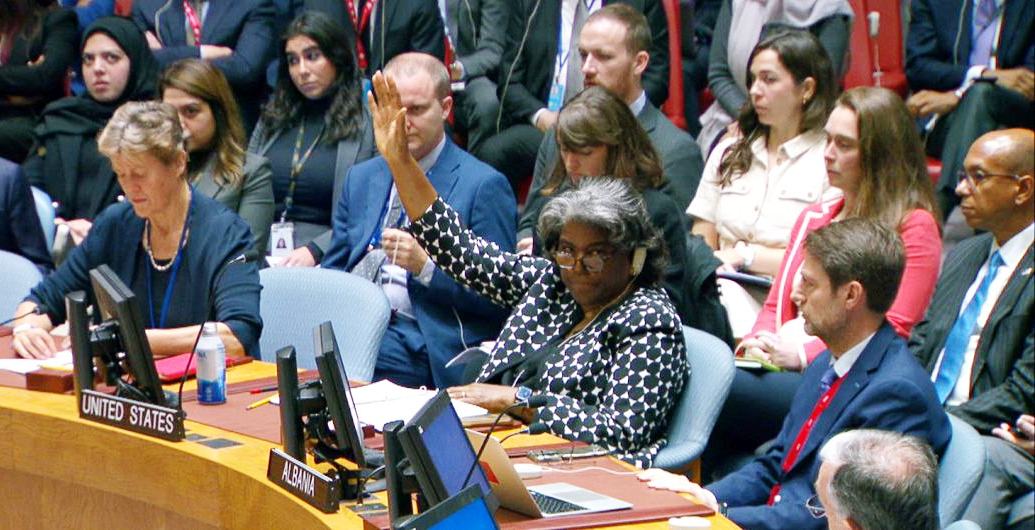
Jeremy Bowen, the BBC’s international editor with decades of exposure covering the Israeli-Palestinian conflict, denoted the obstacles of reporting without being on the situation, highlighting the importance of using one’s own eyes and ears in war reporting.
Jamie Wilson, head of international news at The Guardian, emphasized the challenges faced by media organisations. “While there is longing to provide complete on-the-ground reporting, the life-threatening scenario in Gaza hinders this goal,” Wilson stressed that the choice should be made by news organizations themselves, instead of the Israeli government dismissing access to international journalists.
In the prevailing situation, a finite number of journalists in Gaza encounter difficulties alike the Palestinian population, along with finding a shielded place to live, acquiring food and water, and ensuring their protection. The recent explosions moreover portray how these obstacles impair the world’s ability to get an entire view of the circumstances. News organizations with standard bureaus in Gaza, including The Associated Press, the BBC, Reuters, Agence France-Presse, and Al-Jazeera, are affected by the closure.
Spirit of Duty in Agony
In a grief-stricken moment captured on camera, Wael Dahdouh, a proficient news correspondent, and Al Jazeera‘s Gaza bureau chief found himself dealing with the incomprehensible tragedy of bidding a final farewell to his wife, son, daughter, and grandson. The family had sought refuge in a house during an Israeli air raid in the northern Gaza Strip, an unfortunate incident that claimed several lives.
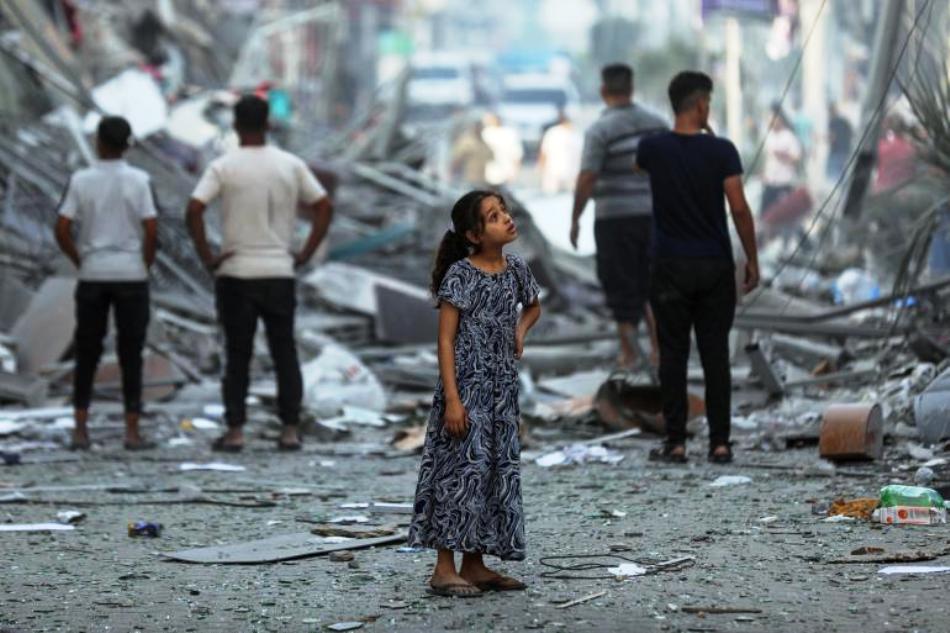
Amal, 7, contemplating her neighbourhood after neighbouring homes were levelled to the ground.
During an interview, Wael, typically habitual to discussing news with collectedness, struggled to hold his emotions. Supported by the wall, distant from the camera, he covered his tears before speaking to the audience. As he spoke, his voice wobbled, shattering particularly when he cited his seven-year-old daughter, Sham, and his grandson, Adam, who was just one and a half years old.
Wael shared the tragic impact of the incident, indicating that his daughters survived but were injured. The family had left behind their home in Tel el-Hawa, Gaza City, due to safety issues and had moved to the Nuseirat refugee camp, hoping for protection in a zone appointed by Israel for Palestinian relocation.
The misfortune hit as Wael, caught in between his journalistic duties in Gaza City and concern for his family, reported on the persistent bombings. His wife, Amna, and their children sought a place of refuge, but fate led them to a house in the northern Gaza Strip, where the air raid ensued.
As a journalist, Wael met the agonizing irony of reporting on an incident only to find that it involved his own family. His daughter Khuloud made it to him during a live report, revealing the crushing disclosure of the loss of his wife, daughter, and grandson.
“It makes up an arduous juncture in the life of a Palestinian journalist when they set out on the task of reporting an event for the news only to uncover that the subject of the news is, in fact, their own family,” he has said.
In that heartrending moment, Wael, alongside cameraman Hamdan al-Dahdouh, promptly reached the scene. Despite their lamentation, they exhaustively probed through the rubble with bare hands. They successfully recovered Wael’s badly injured son Yehia and daughter Batoul but, unfortunately, could not save his grandson Adam.
Hamza Dahdouh, the 27-year-old son of Wael Dahdouh, and a Palestinian journalist lost his life in an Israeli airstrike, marking another profound loss for the proficient reporter. Like his father, Hamza was an Al Jazeera journalist. He died next to a colleague, Mustafa Thuraya, in a strike on their car in the southern city of Rafah.
Despite the sorrow of joining lamenters in grieving and praying over his son’s death, Dahdouh, an image for many encapsulating both personal adversity and unwavering robustness in this war, made a dedicated pledge to persist in his journalistic endeavours.
“Indeed, the pain of losing a loved one is extremely challenging, and when it involves your eldest son, following previous family losses, it becomes even more difficult,” he shared with an NBC News crew in Gaza, seated among mourning relatives while receiving consolation.
Currently, Wael has left Gaza for Egypt for medical treatment of his injuries.
Rightful Heroes
A unit of journalists, including Al Jazeera correspondents Wael Dahdouh and Yomna El Sayed, are being lauded as heroes for their unrelenting journalism in the thick of bombings, communication breakdowns, hunger, and personal setbacks.
Plestia Alaqad, a Palestinian journalist recognised for presenting a rare close-up view of the war in Gaza to millions on social media, has departed the territory with unceasing Israeli bombardments and military blockade. In an Instagram video caption, she explained the choice to leave as one of the toughest, hopeful for the ordeal to end soon. Concerned for her family’s safety, she stopped wearing her press vests and helmet which was once considered as a shield, but now taken as a potential threat.
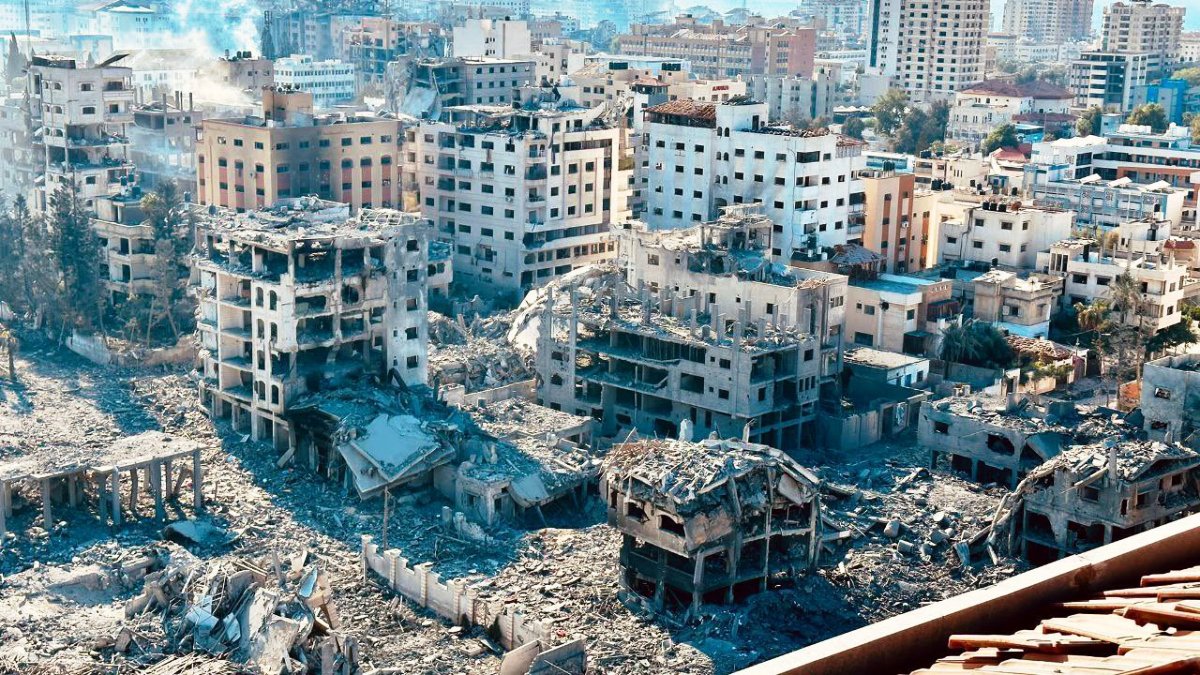
Alaqad, with about 4.8 million Instagram followers, has been a pivotal source of firsthand accounts amid the destruction. Her unaltered reporting has attained widespread recognition, shifting the operations of global media seeking to describe the ongoing situation in Gaza amid power outages and bombardments. NBC News, New York Magazine, and The New York Times have profiled her dispatches, enhancing the significance of her crucial reporting.
Alaqad’s conversion from using Instagram as a platform to enlighten outsiders about daily life in Gaza to becoming a battlefield journalist unfolded rapidly. Before the commencement of the conflict, she was employed by a marketing agency, occupied in media training and utilising Instagram to feature the more dynamic aspects of life in the region. Her posts displayed colourful sun shields at the beach and shared self-captures with friends, all to express to her followers that Gaza was more than just a backdrop for conflict and devastation.
Besides being a journalist covering the news, she highlighted that she was actively going through the incidents she reported. The obstacles she faced included devoting ample time to searching for places to charge her phone or access to sufficient web connectivity for uploading content. These difficulties elevated when power was completely cut, and frequent connectivity outages became typical.
In her recent video, presented in Arabic, Alaqad expressed her profound remorse for leaving the conflict-ridden territory, coupled with a feeling of heartfelt sorrow for the Gaza citizens driven to evacuate their homeland to stay alive.
The video that drove Plestia Alaqad to viral prominence contained bare simplicity entangled with trauma. During the commencement of the attack on Gaza, she took refuge in a neighbour’s flat in Gaza City, meticulously capturing the scene as the residents took precautionary measures by seeking protection indoors. However, the gravity of the situation unfurled drastically as strikes struck recklessly close to the building, covering the surroundings in a dust haze. Alaqad expressed disbelief at her lack of sentimentality during that critical situation causing her to have no response to trauma due to familiarity with the situation.
Belal Jadallah, a prominent Gaza journalist, and his brother-in-law also succumbed to an Israeli attack. Likewise, Moamen Al Sharafi, another journalist for the network, underwent the profound loss of 22 family members in a single attack.
Social Media Role
Given the limited access for international journalists in Gaza, typically involving incorporating with the Israeli military, social media has played a significant role in filling the information blanks. On the ground, a group of young journalists, including 25-year-old filmmaker Bisan Owda and 25-year-old photographer Motaz Azaiza, have shared close encounters of loss and struggle with worldwide viewers.
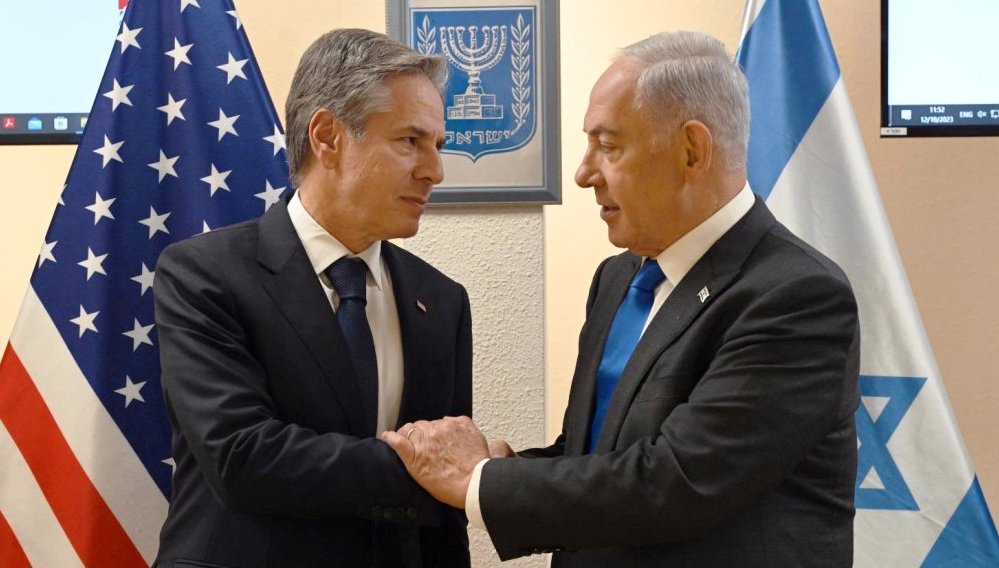
“The war has killed more journalists in Gaza than all journalists killed in World War 2 in just 100 days,” captions Ahmed Eldin, a storyteller on Instagram.
Motaz Azaiza, presently employed as a photographer at UNRWA USA, incepted his career by sharing distinct images on Instagram.
Motaz, was raised in a Gaza refugee camp, and pursued his education in English language and literature at Al-Azhar University, Gaza. Like plentiful of other graduates in Gaza, he faced difficulties in finding encouragement and employment due to the region’s high unemployment percentage.
Confronted by job hurdles, Azaiza shifted to social media, particularly Instagram, where he attained a notable following for his skilful photography. Through his work, Azaiza captures the considerable repercussions of the ongoing conflict on the population of Gaza.
Azaiza, as a Palestinian, has experienced individual misfortune, losing 15 relatives in an Israeli airstrike on his house.
In an interaction with The New Arab, Azaiza shared his tragedy of losing relatives in an air strike and outlined the daunting quality of life he and others endure. He spoke about the persisting formidable challenges faced by Palestinians for 75 years, distancing himself from Hamas and manifesting a deep desire for Gaza and Palestine to be liberated from perpetual conflict.
Emphasising Azaiza’s representation of human power to initiate the anticipated change, the Gentlemen’s Quarterly Magazine revealed that he topped their list in the reward category for the year 2023 as ‘Man of the Year’. The post wrapped up with remarks of gratitude to the GQ Middle East team and sincere prayers for Azaiza’s safety and the welfare of those around him.
“Hi, my name is Motaz, I’m from Gaza. I have no words for you; that is why I’ve risked my life to show you everything I’ve found, everything I’m seeing. Every moment I capture is for you, for the world to take action,” implores photographer Motaz Azaiza in a video shared by the United Nations Relief and Works Agency for Palestine Refugees in the Near East (UNRWA) on his Instagram account.
As one of the prominent media personalities capturing the war in Gaza, Motaz acquired more followers on Instagram than the President of the United States Joe Biden, which gained widespread attention from Palestinian activists all over social media handles, especially Instagram. Currently, Motaz possesses 18.5 million followers while Joe Biden has a hold of 17.1 million causing a contest between the supporters.
His aboveground footage provides a harsh depiction of extensive neighbourhood destruction, while further videos display him carrying a lifeless baby in his arms. Between the strife, he records himself enclosed by Palestinian children making peace signs, captioned as, “We teach you life, people.”
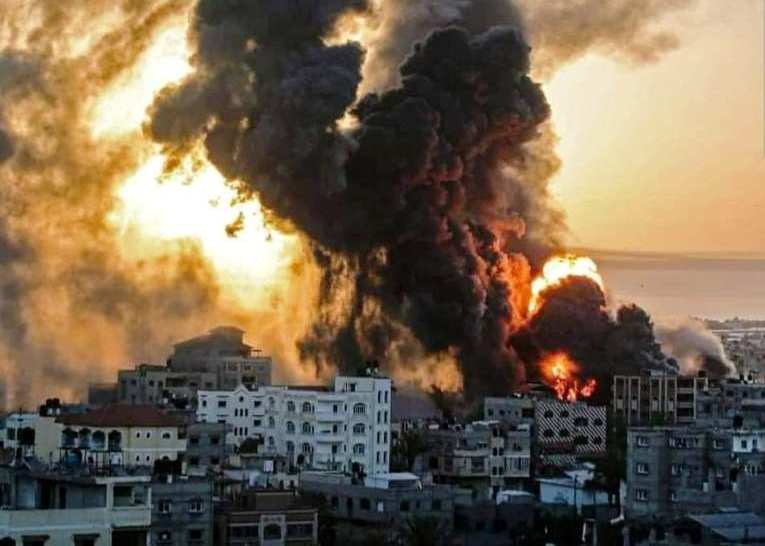
He was also nominated by his followers and admirers as The Person of the Year 2024 for The Time Magazine, which was further given to Taylor Swift (American singer-songwriter). The Tag not given to him also created a hassle on the internet hurting the expected sentiments of his supporters.
Despite the obstacles, he constantly urged the world to facilitate in granting medical necessities and distributing whatever food and water was available. “Every second, I feel less certain of my survival. I appreciate your presence, but please don’t merely watch my content. Please, contribute now, and pray for Gaza.”
After a long endurance of about 107 days in the war zone, Motaz finally took out his vest and left Gaza on January 23, 2024, due to a lot of intricate reasons.
In his recent interview with Al-Jazeera after leaving Gaza, Motaz reflected on the evacuation of Gaza and expressed his feelings of guilt. “I have lost interest in my dreams. I don’t care anymore because, after witnessing the losses I have experienced, I simply long for a normal life. I consistently feel guilty for having clean water, sitting on a comfortable couch, being free from drones overhead, and being spared from witnessing destruction or human suffering. My guilt lingers as I hope for my people to have a similar experience. My mind remains in Gaza until it regains vitality.”
Children Out
Journalist, Noor Harazeen a female reporter evacuated her children outside Gaza through the Rafah border on January 19, 2024, so that they could find food and water easily and sleep tight at night. She has returned by herself to continue detailing the sustained conflict.
Following the spirit of duty, a nine-year-old girl journalist namely Lama Jamous has garnered many followers on social media through her great coverage of the perpetual Israel-Gaza strife.
Another female filmmaker, Bisan Owda also called Wizard Bisan due to her relentless reporting, has also been staying in Gaza since October 7, 2023. She continues to report the immediate details of everyday incidents of the war with the hope of a ceasefire to end the devastation. She along with other prominent journalists like Akram al Satari, and Khawla al Khalidi, who have been capturing the war since the beginning reflect the rigorous updates and disturbing realities of the war.
Many other journalists and notable social media pages like eye.on.palestine, middleeasteye, trtworld continue to capture and display the enduring day-to-day events and real aspects of the war.
Anthony Bellanger, the general secretary of the International Federation of Journalists, told The Associated Press, “Besides the human impact, many media organization facilities in Gaza have been demolished.
He estimated that there were approximately 1,000 journalists and media professionals in Gaza before the conflict.
In a statement released on February 1, 2024, the UN experts revealed that the Isreal-Gaza War has been portrayed as “the most dangerous conflict for journalists in recent history”.
“We express deep regard over the extremely high figures of journalists and media personnel who have been killed, attacked, injured, and detained in the Palestinian Territory, notably in Gaza, in recent months, showing an obvious neglect for international law,” stated the experts.
“We extend our heartfelt homage to the courage and fortitude of journalists and media workers in Gaza who persistently risk their lives daily in the line of duty, enduring significant hardships and tragic losses of colleagues, friends, and families during one of the bloodiest and most ruthless conflicts of our times,” added the experts.
The experts further affirmed, “Journalists deserve protection as civilians under international humanitarian law. Deliberate attacks and homicides targeting journalists constitute war crimes.” They advocated for an unbiased probe into the killings of journalists.
The current list of deceased Journalists in Israel- Gaza War as of March 20, 2024, includes Muhammad Salama, Mohamed Yaghi, Zayd Abu Zayed, Alaa al Hams, Angam Ahmed Adwan, Yasser Mamdouh el Fady, Nafez Abdel Jawad, Rizq al Gharabli, Mohammad Atallah, Iyad el Ruwagh, Wael Fanouneh, Yazan al Zuweidi, Mohamed Jamal Sobhi al Thalathini, Ahmed Bdeir, Mohammad Abu Dayer, Abdullah Baris, Hamza al Dahdouh, Mustafa Thuraya, Akram ElShafie, Jabr Abu Hadrous, Mohamed Khair aldin, Ahmed Khair aldin, Mohamad al Iff, Mohamed Azzaytouniyah, Ahmad Jamal al Madhoun, Mohamed Naser Abu Huwaidi, Mohamed Khalifeh, Adel Zorob, Abdallah Alwan, Assem Kamal Moussa, Haneen Kashtan, Samer Abu Daqqa, Abdel Kreen Odeh, Duaa Jabbour, Mohammad Abu Samra, ala Atallah, Saeed al Shorbaji, Hassan Farajallah, Shaima el Gazzar, Abdullah Darwish, Marwan al Sawaf, Adham Hassouna, Nader al Nazli, Amal Zahed, Mostafa Bakeer, Mohamed Mouin Ayyash, Assem al Barsh, Mohamed Nabil al Zaq, Jamal Hanieh, Ayat Khadoura, Taher al Hassanat, Bilal Jadallah, Abdelhalim Awad, Sari Mansour, Hassouneh Salim, Mostafa el Sawaf, Amro Salah Abu Hayah, Mossab Ashour, Ahmed Fatima, Yaacoub al Barsh, Ahmed al Qara, Yahya Abu Manih, Mohamed Abu Hassira, Mohamed al Jaja, Haitham Harara, Mohamad al Bayyari, Mohammed Abu Hatab, Majd Fadl Arandas, Iyad Matar, Imad al Wahidi, Majed Kashko, Nazmi al Nadim, Yasser Abu Namous, Duaa Sharaf, Zaher al Afghani, Jamal al Faqaawi, Saed al Halabi, Ahmed Abu Mhadi, Salma Mkhaimer, Mohammed Imad Labad, Roshdi Sarraj, Roee Idan, Hani Madhoun, Mohammed Abu Ali, Khalil Abu Aathra, Sameeh al Nady, Mohammad Balousha, Issam Bhar, Abdulhadi Habib, Yousef Maher Dawas, Salam Mema, Husam Mubarak, Ahmed Shehab, Mohamed Fayez Abu Matar, Saeed al Taweel, Mohammed Sobh, Hisham Alnwajha, Assaad Shamlakh, Mohammad Al-Salhi, Mohammad Jarghoun, Ibrahim Mohammad Lafi, and counting. (Palestinian)
Shai Regev, Ayelet Arnin, Yaniv Zohar, Roy Edan. (Israeli)
Issam Abdallah, Farah Omar, Rabih al Maamari. (Lebanese)
Sherif Mansour, CPJ’s Middle East and North Africa programme coordinator, speaking to The Time Magazine, stated, “Gaza’s Palestinian journalists find themselves mostly unassisted, left to tackle hurdles single-handedly. The shortfall of infrastructure, protection, and safety measures places them in a vulnerable situation. Despite the inadequacy of resources, Gaza’s journalists persist, holding the responsibility of reporting on the ongoing incidents until their capacity is edgy.”
Mansour signified their important role on the battlefront, accepting that they are both fundamental and exceptionally vulnerable in the face of adversity.
Recently, a great group of leaders from global news organisations signed a letter conveying support for journalists in Gaza. The Committee to Protect Journalists led the release of the letter and mentioned that they wanted the journalists to be safe and free to report on what was happening during the war. They cited that many journalists and media workers, most of them Palestinians, have been killed in the war between Israel and Hamas. The letter emphasises that journalists are civilians, and according to international law, Israeli authorities should protect them like civilians. Anyone who doesn’t follow the rules should face consequences.
The letter also reflected that attacking journalists is like attacking the truth itself. It reflects working hard to keep journalists safe in Gaza, crucial for press freedom.
Jodie Ginsberg, the CEO of the Committee to Protect Journalists, encouraged more organizations to join in. She also quoted that “it’s important to show that the international journalism community supports their Palestinian colleagues and stands in solidarity with them.”
(The author is a student and an intern with Kashmir Life. Ideas are personal.)














